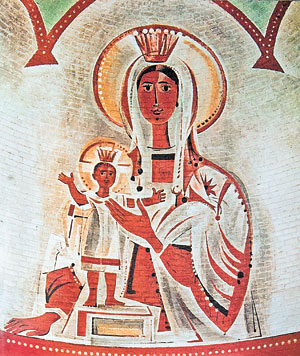Fedir Stravinsky — artist who lived in harmony with the universe

Photo replicas by Yaroslav MIZERNY
The Day found out about the artist Fedir Stravinsky in the town Ustyluh, Volyn, in the memorial estate of his father – world-wide known musician Ihor Stravinsky. Looking through the unique publications dedicated to this talented family collected for the museum exposition by the director Volodymyr TERESHCHUK, we came across an album printed in France with photo replicas of paintings by Fedir Stravinsky. Surprised, we asked Mr. Tereshchuk whether Stravinsky’s son was a painter. As it turned out, he was a very talented artist well known in artic circles in Europe.
The oldest son of the musician and his first wife Kateryna Nosenko was born in 1907 in Saint Petersburg. He was named Fedir after his grandfather – famous in Russian Empire opera singer of Ukrainian origin.
Remarkably, the artist’s childhood is closely connected with Volyn. After building a house in Ustyluh, Ihor Stravinsky would come there every summer with his family. By the way, the Stravinskys’ Volynian estate is the world’s only building designed by the misician, which has been preserved after his death.
In 1913 the family settled in the Swiss town Morges and seven years later they moved to France. The Stravinskys never came back to Volyn after that. At first, the war was an obstacle and then the victory of Bolshevism and creation of the Soviet Union, where the musician was persona non grata.
To be a son of Ihor Stravinsky meant to grow up in an environment, where much attention was paid to art in various forms. Music was pretty close to theater, and theater, in its turn, to painting. Artists frequently visited Stravinskys’s house. Pablo Picasso, who was friends with Fedir’s (or Teodor – this is how he is known in Europe) father, lived not far from the family. The family was also friends with Henri Matisse, Andre Derain, Georges Braque, Paul Valery, and Jean Cocteau.
Apart from classical education, Fedir Stravinsky also received art education. His teachers were Andre Derain and Georges Braque.
By the way, in Stravinskys’ family there was no conflict between the father and the son. Fedir was fond of his father’s work but did not try to transfer it into his own work. At the same time father’s example encouraged him to work, to discipline, and to search, however, obliged him to be faithful to himself, to bold innovations, and rejection of conservative forms. His individual calling revealed itself so early and strongly that he didn’t have to fight the temptation to become Stravinsky No.2.
“I have always been painting,” Fedir said about himself. He created his first painting known to experts when he was 11: it is a picture of the premiere of Ihor Stravinsky play The Soldier’s Story.
The first exhibition of Fedir Stravinsky’s works opened in 1927 in Paris. However, later throughout his long life – the artist died two years before the fall of the Soviet Union – he worked not only with easel, but also created wall murals, stained glass, mosaics, and tapestries. Sometimes he painted scenery for a theater. Stravinsky also illustrated numerous fiction books, including those written by Albert Camus and Henry de Montherlant.
Fedir Stravisky painted churches in many countries. For this in 1977 Pope Paul VI awarded Stravinsky the title of the Commander of the Order of St. Gregory the Great “for aiding the church with artistic ability.” By the way, as Fedir admitted himself, he always felt the connection with the Orthodox tradition in Christianity, its mysticism.
From 1936 until his death Stravinsky Jr. lived in Switzerland and died in Geneva on May 16, 1989 in the age of 83 years. Friends remembered Fedir Stravinsky as an artist who devoted himself to clear expression of the refined world, rejecting any compromise with civilization of laziness and vulgarity; the one who was used to look up and far more than daily troubles allow; the one who lived in ideal harmony with the Universe, dreaming about great monumental compositions.
While writing the article the author used the information from Maurice Zermatten’s photo album Theodore Strawinsky: L’oeuvre monumentale (Fedir Stravinsky: Monumental Works), 1990, Enrico Monti Foundation






